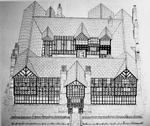
Arley Hall c 1600-1750s Welcome Welcome to the Arley Hall Archives. This website illuminates life and work in a country house in Cheshire in the period 1750–1790 by making available some of the extraordinarily detailed accounts and documents that survive at Arley. Over six thousand original receipted invoices have been scanned and fully indexed in a database to show names of suppliers, occupations of suppliers, goods and services provided, companies and either the location of suppliers or the place where the work was done. Forming a unique resource of invaluable primary evidence for historians, researchers, authors and students, the archive has already provided the basis for four books by Charles F Foster, available mail-order from Arley Hall Press. For example it is possible to search on Manchester, get a list of the invoices from there and then to look at the original invoices of many shops there. The same can be done for suppliers in London, Liverpool, Warrington and elsewhere. Every aspect of life is covered - what the staff ate, the plants they bought for the gardens, the textiles they bought and what the tailors made with them - and much more. As well as the invoices, there are additional resources on other topics, including the rents paid, farming, corn milling, the staff, taxes and the poor. 
As this example original invoice shows, suppliers presented meticulous details of the goods supplied. John Harling , like, many other suppliers, had developed an elaborate letterhead for his company. Show this example in the archive Many aspects of the way of life described were probably identical to those in country houses all over England - the servants, the clothes, the food, the amusements and the journeys. The local agriculture stands out though because Cheshire farms specialized in dairy cattle to produce cheese. The other big difference was that Arley was in the middle of the area where the Industrial Revolution was getting under way. The two river navigations on the Mersey and the Weaver, built in the 1730s, were improved in this period. The first canals - the Sankey, the Bridgewater and the Trent and Mersey - were built in the 1750s and '60s. All these canals run within six miles of Arley. Their construction caused a big reduction in the price of heavy goods, such as coal, lime and Baltic timber. New turnpike roads were built allowing quicker travel. Trade greatly increased so that a wider range of goods appeared in the shops and the family went more frequently to Manchester and Liverpool to see them. During this period wages rose by about 30% to 50%. |
Visit Arley Hall
Arley Hall, one of the most interesting and attractive stately homes in the North West of England, and its celebrated gardens are open to the public. For more information, visit arleyhallandgardens.com. The family The Warburton family built the first Arley Hall in 1470, having owned the land since before 1200. Sir Peter Warburton, 4th Baronet, inherited the estate in 1743. He married Lady Betty, eldest daughter of the 11th Earl of Derby, in 1745 and they had five children who grew to be adults; Ann, born in 1748, who died of smallpox in 1769, Margaret, b. 1753, Peter, b. 1754, Harriet, b. 1758, and Emma, b. 1759. Between 1755 and 1763 the family lived in Aston Park, a smaller house on the Estate about 2 miles away, while extensive building work was done to modernize Arley Hall.
Sir Peter, 5th Baronet, inherited while still at Oxford. He was friendly with his first cousin, Edward, two years older than himself, who became the 12th Earl of Derby in 1776. They enjoyed hunting, horse racing, cock–fighting and amateur dramatics together. In 1781 Sir Peter married Alice, daughter of John Parker of Astle. Sadly they had no children and the Estate passed in 1813 to the eldest grandson of his sister Emma. Sir Peter, 4th Baronet, died in 1774 and Lady Betty went to live with her sister in Knutsford a year or two later. Arley Hall is now owned by Viscount Ashbrook. More information on the family's history can be found in Charles Foster's new book The Flowers and Ashbrooks of Durrow which can be downloaded from the Arley Hall Press page. | ||
|
Copyright and licence information This website and all text, images and the archived documents are the copyright of the trustees of Arley Hall and have made been made available for research and educational purposes only. Documents, images and text may be copied for private study but otherwise may not be copied, printed, downloaded, posted or reproduced in any manner, in whole or in part, without the prior written permission of the trustees. For permission to reproduce this material or licences for commercial use, please contact us. Documents, text and images (C)Copyright 2013-2019 Arley Hall Archives. All rights reserved. Site Manager | |||



